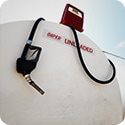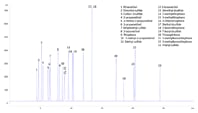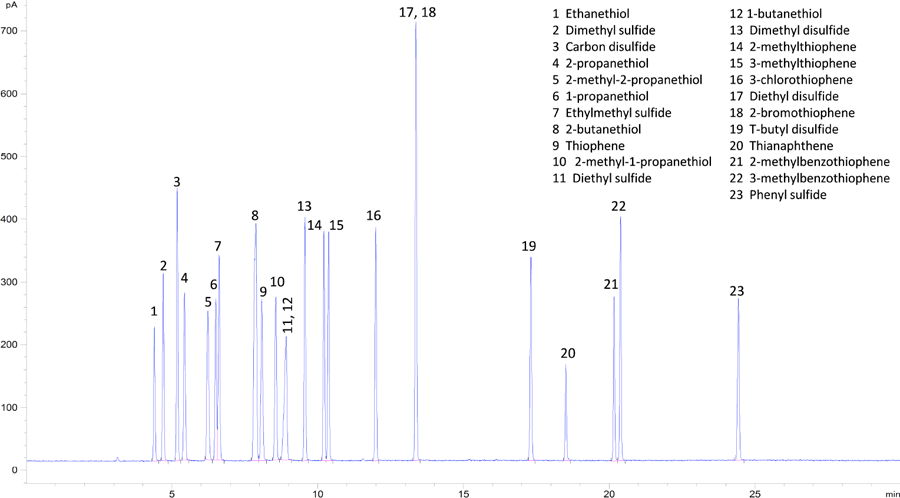Access Agilent eNewsletter November 2015
>> Update My Profile | Subscribe to Access Agilent | Article Directory

Agilent 8355 SCD delivers sensitive, reliable sulfur analysis in petrochemical samples
By Kathy Mills
Agilent Global Marketing Manager
Being able to measure sulfur hydrocarbon matrixes has been a growing concern over the last couple of decades. Global communities are continuously regulating the levels of sulfur concentration in diesel and gasoline with a goal of minimizing pollution and environmental impact. North America, Europe, and Asia are all making concerted efforts to strictly monitor sulfur concentrations.
For example, in the USA, the Environmental Protection Agency has implemented the Ultra Low Sulfur Diesel (ULSD) program. The amount of sulfur permitted in the final product cannot exceed 15 parts per million (ppm). Additional specifications for this mandate are detailed in 40 CFR Part 80 subpart I.
In Europe, standards for sulfur concentrations are defined by the European Union Directive 2009/30/EC. The regulation standards were initially started in 1993 and have been on a progressive schedule to continuously reduce the amount of accepted sulfur in fuels. The most recent changes to the regulations are reflected in 2009.01 and allow a maximum sulfur limit of 10 ppm for diesel fuels for highway vehicles.
And in Asia, a good example of environmental stewardship is being set by China. Beijing has adopted the Euro 5-equivalent fuel standard and regulates a 50 ppm maximum sulfur content in diesel. Hong Kong is taking an even more aggressive approach, allowing only a 10 ppm maximum sulfur level in diesel.
Characterizing ingredients and monitoring progression of sample are keys to success
Meeting compliance is not achieved by simply testing the final product before release. Manufacturers are being faced with a significant production challenge. Producing a low sulfur fuel means that the refining process must be optimized, and the only way to ensure that a process is optimized is to characterize the starting ingredients and monitor the progression of the sample. Not knowing the sulfur content presents a challenge in the laboratory, and having a detector that can measure large differences in the same sequence is essential. As an example, in Table 1 we show test results achieved using Agilent instrumentation in analysis of the compound t-butyl disulfide.
Concentration |
Mean |
Standard Deviation |
Percent RSD |
|---|---|---|---|
|
0.1 ppm |
0.099 |
0.007 |
6.8 |
|
1 ppm |
0.92 |
0.06 |
6.3 |
|
10 ppm |
1.0 |
0.2 |
2.4 |
|
100 ppm |
97 |
3 |
3.3 |
|
1,000 ppm |
1025 |
46 |
3.5 |
Table 1. This chart demonstrates the performance of the compound t-butyl disulfide.
 Enlarge
Enlarge
Figure 1. This chromatogram shows 23 unique sulfur compounds at 1 ppm on-column.
The importance of improved burner design, fewer components, and easier serviceability
Being able to test and clearly identify sulfur compounds in the raw crude can be challenging (Figure 1). Ideally, the process starts with clean, sweet crude and runs smoothly. However, if you start with dirty, sour crude, the process will have its challenges. Using a sulfur chemiluminescence detector offers many benefits when running complex, dirty, raw, or even finished hydrocarbon matrixes, including:
- Dual-plasma design eliminates quenching (signal suppression) caused by coelution of sulfur compounds and hydrocarbons
- Simple to maintain and operate
- ASTM Method D 5623 and D 5504 compliant
The newly designed Agilent 8355 Sulfur Chemiluminescence Detector (SCD) offers significant improvements over any other SCD in the marketplace. One improvement is the burner design. Knowing that this is the main component of operational excellence and the main component of user interaction for maintenance, Agilent dramatically improved the 8355 SCD. The number of components was reduced by almost 50% making operator engagement much easier. Serviceability was also enhanced by making the most frequently serviced component – the ceramic liner – accessible in a 10-minute operation. To put this in perspective, changing the liner on the older design typically took over an hour. These enhancements directly correlate to more uptime and increased instrument readiness.
Agilent 8355 SCD easily exceeds all global regulation requirements
The Agilent 8355 SCD has been reimagined and redesigned to meet the rigor required by the industry. In addition to the hardware improvements, the analytical performance has been tested to exceed all global regulation requirements by over two orders of magnitude of sensitivity. By integrating the Agilent 8355 SCD with the industry leading Agilent 7890B GC, running sulfur analysis has never been more reliable or routine.
Explore a wide selection of gas chromatography solutions
Agilent offers a vast array of gas chromatography solutions, including sulfur chemiluminescence and selective detectors for a variety of compounds. Contact an Agilent sales representative today to find out how these solutions can benefit your busy lab.
>> Update My Profile | Subscribe to Access Agilent | Article Directory
